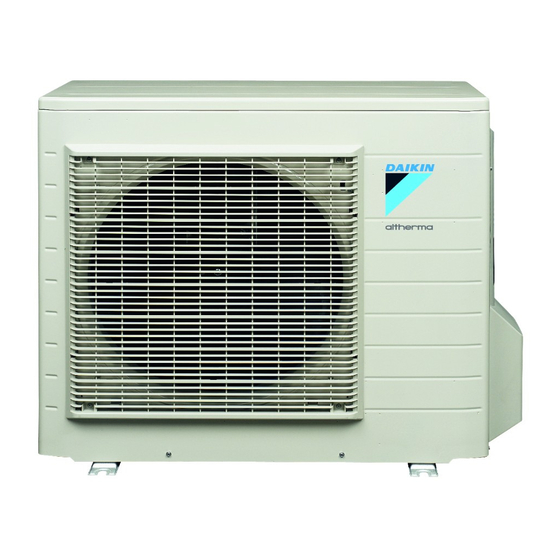
Summarization of Contents
1. DEFINITIONS
1.1. Meaning of warnings and symbols
Explains the meaning of warning symbols used in the manual to indicate hazards and precautions.
1.2. Meaning of used terms
Defines key terms used throughout the installation manual for clarity and consistent understanding.
2. GENERAL SAFETY PRECAUTIONS
Electrical Shock Safety
Critical safety instructions for preventing electrical shock, including power disconnection and voltage checks.
Piping and Internal Parts Safety
Warning against touching hot or cold piping and internal parts to prevent burns or frostbite.
3. BEFORE INSTALLATION
3.1. Scope of the manual
Outlines the procedures covered in the manual for handling, installing, and connecting ERHQ and ERLQ units.
3.2. Precautions for R410A
Details strict precautions for handling R410A refrigerant, emphasizing cleanliness, dryness, and proper charging procedures.
3.3. Installation
Provides essential steps and warnings for the installation process, including checking model numbers and service panels.
3.4. Model identification
Explains how to identify the unit model and its specifications, including series, capacity, and operating zones.
3.5. Accessories
Lists the accessories included with the unit and explains how to check their inclusion.
4. OVERVIEW OF UNIT
4.1. Opening the unit
Instructions on how to open the unit for access, with safety warnings for electrical and internal parts.
4.2. Main components
Identifies and lists the main components of the outdoor unit, with reference numbers for diagrams.
4.3. Functional diagram
Presents a functional diagram of the unit's operation, illustrating key components and flow paths.
5. SELECTING INSTALLATION SITE
5.1. General
General guidelines for selecting an installation site, considering factors like ventilation, noise, space, and safety.
6. PRECAUTIONS ON INSTALLATION
6.1. Foundation work
Details requirements for proper foundation work, including strength, leveling, and secure fixing of the unit.
6.2. Drain work
Guidelines for ensuring proper drainage of water from the unit during heating and defrost operations to prevent ice buildup.
7. INSTALLATION SERVICING SPACE
7.1. Outdoor unit installation drawing
Provides a drawing illustrating the required installation and servicing space around the outdoor unit.
8. REFRIGERANT PIPE SIZE AND ALLOWABLE PIPE LENGTH
8.1. Selection of piping material
Specifies the required construction material and temper grade for refrigerant piping, emphasizing copper.
8.2. Refrigerant pipe size
Details the recommended refrigerant pipe sizes for gas and liquid pipes, matching outdoor connections.
8.3. Allowable pipe length and height difference
Outlines the maximum allowable lengths and height differences for refrigerant piping between indoor and outdoor units.
10. REFRIGERANT PIPING
10.1. Flaring the pipe end
Step-by-step instructions for properly flaring the end of refrigerant pipes to ensure a secure connection.
10.2. Connecting the refrigerant piping to the outdoor unit
Detailed guidance on connecting refrigerant piping to the outdoor unit, including safety warnings and material selection.
10.3. Refrigerant piping work
Covers pipe handling guidelines, bending radius, and selection of copper and heat insulation materials for piping work.
11. LEAK TEST AND VACUUM DRYING
11.1. General guidelines
Provides essential guidelines for performing leak tests and vacuum drying of the refrigerant piping system.
12. CHARGING REFRIGERANT
12.1. Important information regarding the refrigerant used
Details about the refrigerant used, its properties, and necessary labeling requirements for compliance.
12.2. Precautions and general guidelines
Crucial precautions and general guidelines for safely charging refrigerant, including avoiding liquid hammer and using protective gear.
12.3. Calculating the additional refrigerant
Instructions on how to calculate the additional amount of refrigerant needed based on piping length for optimal system performance.
12.4. Complete recharging
Guidance on complete recharging procedures, including referencing the unit nameplate for refrigerant type and amount.
13. PUMP DOWN OPERATION
13.1. Pump down procedure
Step-by-step procedure for pumping down refrigerant to protect the environment when relocating or disposing of the unit.
13.2. Forced cooling operation
Instructions on how to initiate and stop forced cooling operation, a necessary step for pump down.
14. ELECTRICAL WIRING WORK
14.1. Precautions on electrical wiring work
Essential precautions for electrical wiring, emphasizing professional installation, earthing, and circuit protection.
14.3. Connecting power supply and interunit wiring
Detailed instructions and diagrams for connecting power supply and interunit wiring, including wire types and terminal connections.
14.4. Electrical characteristics
Provides electrical specifications and characteristics of the unit, including voltage and current requirements.
15. TEST OPERATION
15.1. Pre-run checks
Lists essential pre-run checks to be performed before starting the unit to ensure proper installation and safety.
15.2. Trial operation and testing
Guidance on conducting trial operation and testing to verify all unit functions and parts are working correctly.
16. MAINTENANCE AND SERVICING
16.1. Service precautions
Important precautions to ensure optimal unit operation and safety during regular maintenance and inspection intervals.
16.2. Service mode operation
Instructions on how to access and utilize the service mode for advanced maintenance and diagnostics.
18. UNIT SPECIFICATIONS
18.1. Technical specifications
Lists the technical specifications of the unit, including casing, dimensions, weight, and operating ranges.
18.2. Electrical specifications
Provides electrical specifications and characteristics of the unit, including phase, frequency, and voltage ranges.

















Need help?
Do you have a question about the ERHQ007BBV3 and is the answer not in the manual?
Questions and answers